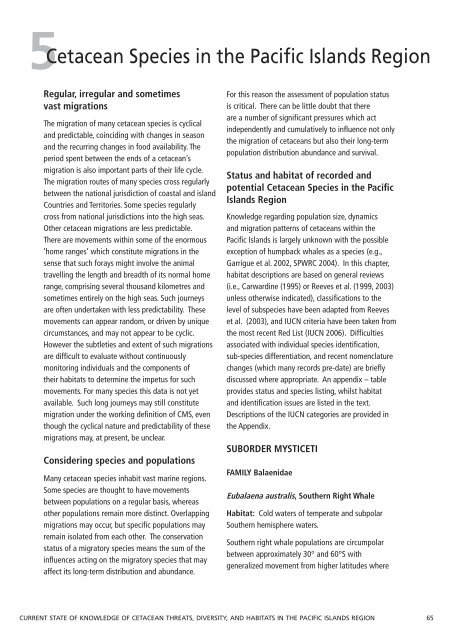pacific islands report_NU.indd - Whale and Dolphin Conservation ...
pacific islands report_NU.indd - Whale and Dolphin Conservation ...
pacific islands report_NU.indd - Whale and Dolphin Conservation ...
You also want an ePaper? Increase the reach of your titles
YUMPU automatically turns print PDFs into web optimized ePapers that Google loves.
5Cetacean Species in the Pacific Isl<strong>and</strong>s RegionRegular, irregular <strong>and</strong> sometimesvast migrationsThe migration of many cetacean species is cyclical<strong>and</strong> predictable, coinciding with changes in season<strong>and</strong> the recurring changes in food availability. Theperiod spent between the ends of a cetacean’smigration is also important parts of their life cycle.The migration routes of many species cross regularlybetween the national jurisdiction of coastal <strong>and</strong> isl<strong>and</strong>Countries <strong>and</strong> Territories. Some species regularlycross from national jurisdictions into the high seas.Other cetacean migrations are less predictable.There are movements within some of the enormous‘home ranges’ which constitute migrations in thesense that such forays might involve the animaltravelling the length <strong>and</strong> breadth of its normal homerange, comprising several thous<strong>and</strong> kilometres <strong>and</strong>sometimes entirely on the high seas. Such journeysare often undertaken with less predictability. Thesemovements can appear r<strong>and</strong>om, or driven by uniquecircumstances, <strong>and</strong> may not appear to be cyclic.However the subtleties <strong>and</strong> extent of such migrationsare difficult to evaluate without continuouslymonitoring individuals <strong>and</strong> the components oftheir habitats to determine the impetus for suchmovements. For many species this data is not yetavailable. Such long journeys may still constitutemigration under the working definition of CMS, eventhough the cyclical nature <strong>and</strong> predictability of thesemigrations may, at present, be unclear.Considering species <strong>and</strong> populationsMany cetacean species inhabit vast marine regions.Some species are thought to have movementsbetween populations on a regular basis, whereasother populations remain more distinct. Overlappingmigrations may occur, but specific populations mayremain isolated from each other. The conservationstatus of a migratory species means the sum of theinfluences acting on the migratory species that mayaffect its long-term distribution <strong>and</strong> abundance.For this reason the assessment of population statusis critical. There can be little doubt that thereare a number of significant pressures which actindependently <strong>and</strong> cumulatively to influence not onlythe migration of cetaceans but also their long-termpopulation distribution abundance <strong>and</strong> survival.Status <strong>and</strong> habitat of recorded <strong>and</strong>potential Cetacean Species in the PacificIsl<strong>and</strong>s RegionKnowledge regarding population size, dynamics<strong>and</strong> migration patterns of cetaceans within thePacific Isl<strong>and</strong>s is largely unknown with the possibleexception of humpback whales as a species (e.g.,Garrigue et al. 2002, SPWRC 2004). In this chapter,habitat descriptions are based on general reviews(i.e., Carwardine (1995) or Reeves et al. (1999, 2003)unless otherwise indicated), classifications to thelevel of subspecies have been adapted from Reeveset al. (2003), <strong>and</strong> IUCN criteria have been taken fromthe most recent Red List (IUCN 2006). Difficultiesassociated with individual species identification,sub-species differentiation, <strong>and</strong> recent nomenclaturechanges (which many records pre-date) are brieflydiscussed where appropriate. An appendix – tableprovides status <strong>and</strong> species listing, whilst habitat<strong>and</strong> identification issues are listed in the text.Descriptions of the IUCN categories are provided inthe Appendix.SUBORDER MYSTICETIFAMILY BalaenidaeEubalaena australis, Southern Right <strong>Whale</strong>Habitat: Cold waters of temperate <strong>and</strong> subpolarSouthern hemisphere waters.Southern right whale populations are circumpolarbetween approximately 30° <strong>and</strong> 60°S withgeneralized movement from higher latitudes whereCURRENT STATE OF KNOWLEDGE OF CETACEAN THREATS, DIVERSITY, AND HABITATS IN THE PACIFIC ISLANDS REGION 65
















